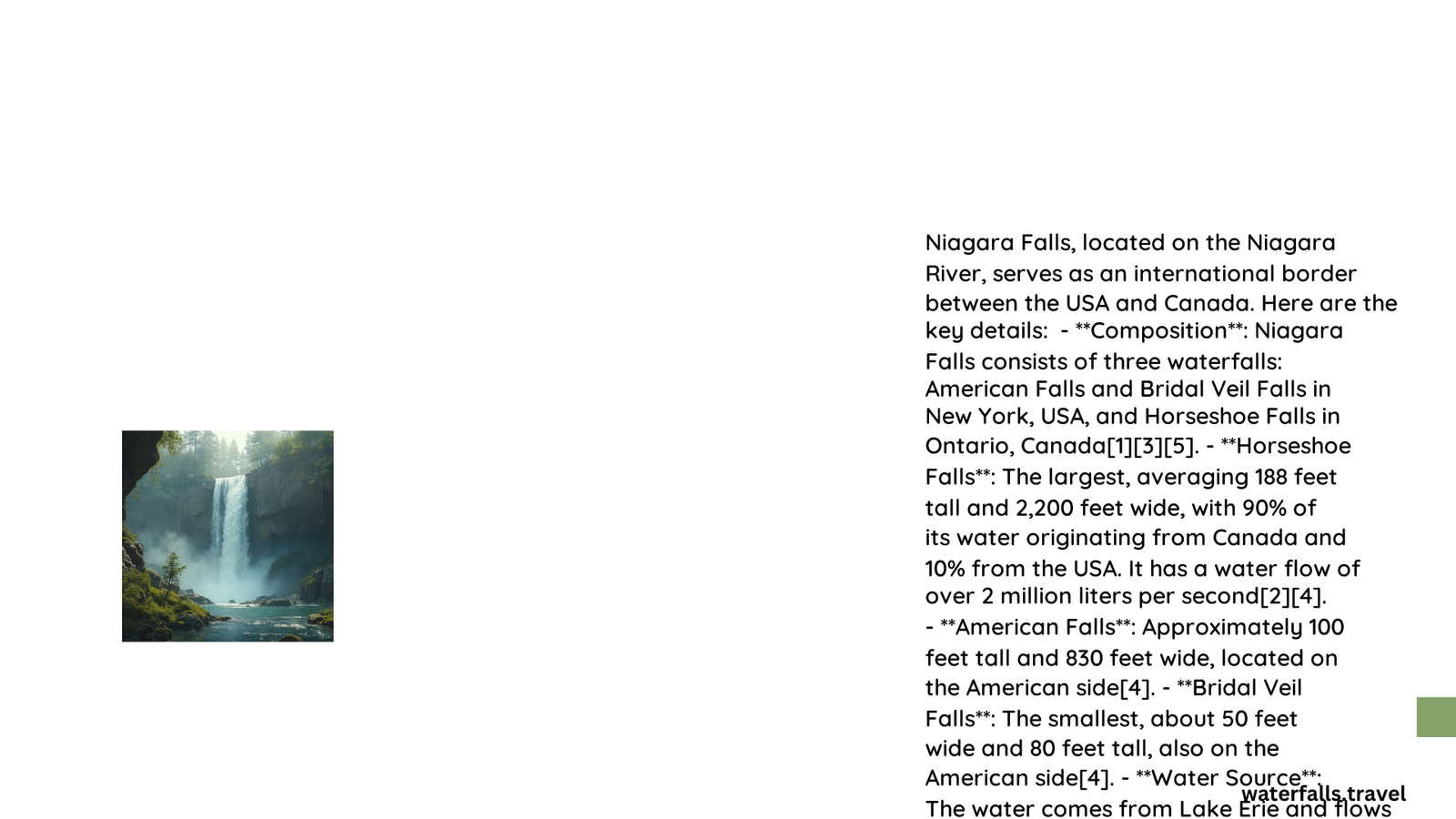Niagara Falls, the iconic waterfall between New York and Canada, is a natural wonder that attracts millions of visitors annually. Straddling the international border, this magnificent cascade comprises three distinct waterfalls: the Horseshoe Falls, American Falls, and Bridal Veil Falls. With a combined flow rate of approximately 600,000 U.S. gallons per second, Niagara Falls offers breathtaking views, thrilling experiences, and a rich history that captivates tourists from around the globe.
What Are the Key Features of Niagara Falls?
Niagara Falls, the waterfall between New York and Canada, boasts impressive dimensions:
- Canadian Horseshoe Falls:
- Height: 167 feet (50.9 meters)
- Width: 2,600 feet (792.4 meters)
-
Flow Rate: Approximately 600,000 U.S. gallons per second
-
American Falls:
- Height: 70-110 feet (21-34 meters)
-
Width: 1,060 feet (323 meters)
-
Bridal Veil Falls:
- Height: 78 feet (24 meters)
- Width: 56 feet (17 meters)
Where Are the Best Viewpoints for Niagara Falls?

To fully appreciate the waterfall between New York and Canada, consider these prime viewing locations:
- Canadian Side:
- Table Rock Welcome Centre
- Queen Victoria Park
- Skylon Tower
-
Journey Behind the Falls
-
American Side:
- Prospect Point
- Goat Island
- Cave of the Winds
- Observation Tower
What Tours Are Available at Niagara Falls?
Explore the waterfall between New York and Canada through various exciting tours:
- Maid of the Mist Boat Tour
- Duration: 1 hour
- Cost: $25-$30 per person
-
Experience: Close-up view of the falls’ base
-
Cave of the Winds Tour
- Duration: 1-2 hours
- Cost: $20-$30 per person
-
Experience: Descend into Niagara Gorge and stand on Hurricane Deck
-
Niagara Falls Helicopter Tour
- Duration: 10-15 minutes
- Cost: $100-$150 per person
-
Experience: Aerial view of the falls and surrounding area
-
Guided Walking Tours
- Duration: 2-4 hours
- Cost: $50-$100 per person
- Experience: Historical sites and various viewpoints
When Is the Best Time to Visit Niagara Falls?
The optimal time to visit the waterfall between New York and Canada depends on your preferences:
| Season | Temperature | Crowds | Pros | Cons |
|---|---|---|---|---|
| Summer (Jun-Aug) | 70°F (21°C) | High | Warm weather, all attractions open | Large crowds |
| Spring (Apr-May) | 50-60°F (10-15°C) | Moderate | Mild weather, fewer crowds | Some attractions may have limited hours |
| Fall (Sep-Oct) | 50-60°F (10-15°C) | Moderate | Beautiful foliage, fewer crowds | Cooler temperatures |
| Winter (Dec-Feb) | 30°F (-1°C) | Low | Unique ice formations, fewer crowds | Cold weather, some attractions closed |
What Events and Festivals Occur at Niagara Falls?
Throughout the year, the waterfall between New York and Canada hosts various events:
- Niagara Falls Fireworks (nightly during summer)
- Niagara Falls Illumination (year-round, evenings)
- Winter Festival of Lights (mid-November to mid-January)
- Niagara Wine Festival (September)
How Accessible Is Niagara Falls for Visitors?
Accessibility options for the waterfall between New York and Canada include:
- Parking: Available on both sides, costing $10-$30 per day
- Public Transport:
- Canadian side: WEGO Visitor Transportation System
- American side: Niagara Scenic Trolley
- Wheelchair Accessibility: Most major attractions and viewpoints are accessible
What Are the Border Crossing Rules for Niagara Falls?
To visit the waterfall between New York and Canada, remember:
- Valid passport, enhanced driver’s license, or NEXUS card required
- Be prepared to answer questions about your trip
- Certain items may be restricted or require declaration
By following these guidelines, visitors can fully enjoy the majestic Niagara Falls, experiencing the power and beauty of this natural wonder that spans the border between New York and Canada.
